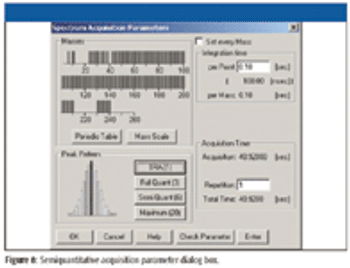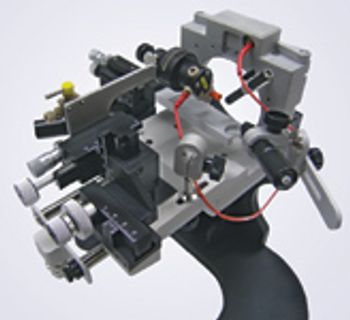
Special Issues-11-01-2007

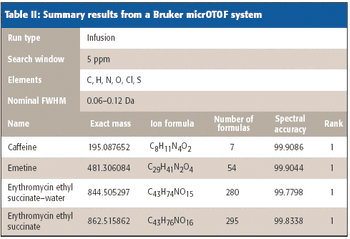
Special Issues
Mass spectrometry has become a fundamental tool for compound identification or confirmation by virtue of its ability to obtain elemental composition determination (formula identification) by accurate mass measurements. The speed, sensitivity, and ease of interfacing the technique with gas chromatography and liquid chromatography make it the technique of choice for many applications. However, accurate mass measurements must be made with care, and sometimes they can require careful calibration procedures and validation methods. In addition to accurate mass measurements, the isotope abundance distribution also provides information unique to a given chemical formula. However, the mass spectral accuracy required for accurate isotope modeling has not been easy to obtain previously. More recent approaches (1–3) that calibrate the spectral line-shape show promise in obtaining the necessary level of spectral accuracy but still require careful calibration methods with the use of known standards. This article..
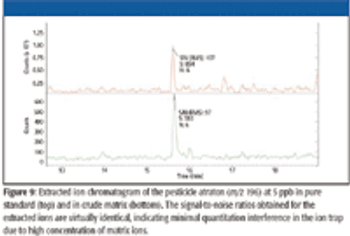
Special Issues
Today's ion traps use advanced scanning techniques such as automatic gain control, axial modulation, and triple resonance scanning, resulting in efficient control of both ionization and optimal storage of ions in the trap during analysis. These instruments provide excellent sensitivity and quantitative data, even in "dirty" samples.
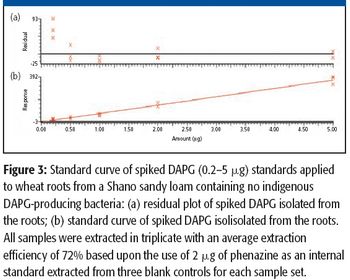
Special Issues
Root diseases caused by soilborne plant pathogens are responsible for billions of dollars of losses annually in food, fiber, ornamental, and biofuel crops. The use of pesticides often is not an option to control plant diseases because of economic factors or potential adverse effects on the environment or human health. For this reason, many Americans are now buying pesticide-free organic foods. Organic agriculture has few options for controlling pests and thus must make full use of natural microbial biological control agents in soils that suppress diseases.
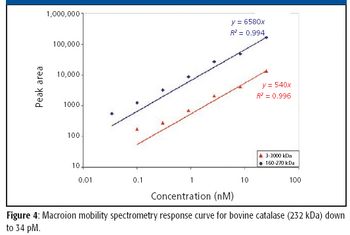
Special Issues
Mass spectrometry (MS) has advanced to analyze ever-larger biomolecules with the invention of soft ionization techniques like electrospray ionization (ESI). Although ESI has provided a method of generating ions of high mass, mass spectrometers generally suffer both lower sensitivity and lower resolution as the mass-to-charge ratio of an ion increases. To extend the mass range of ionized macromolecules beyond the limits of MS, macroion mobility spectrometry utilizes ion mobility sizing to characterize charge-reduced ESI-generated macroions from >5 kDa to beyond megadalton masses. One prominent application of macroion mobility spectrometry, highlighted here, is the high sensitivity analysis of intact proteins, antibodies, and conjugates in which molecular masses range from antibody light-chain fragments to high mass immunoglobulin multimers.
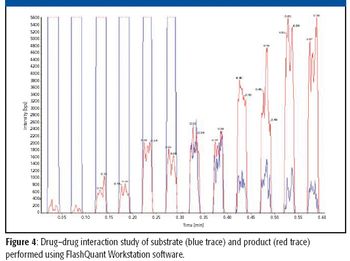
Special Issues
Drug discovery scientists are continually striving to improve productivity and efficiency in their workflows. From early discovery to clinical development, existing workflow bottlenecks represent an opportunity to develop solutions to speed the process and improve productivity. The key requirements for quantitative analysis are precision, accuracy, and linear dynamic range. With any quantitative instrument, the hope is that it will be applicable to a vast range of coumpounds, ruggest, and fast. New mass spectrometry (MS) technologies are being developed that meet these criteria and permit high throughput while enabling its application to areas in which speed limitations previously curtailed its practicality. In particular, in the area of ADME profiling, new MS platforms are becoming available that increase the throughput by at least 25-fold, by combining the speed of matrix-assisted laser desorption ionization (MALDI) with the specificity of triple-quadrupole MS. This is bound to greatly accelerate the ADME..

Special Issues
This article describes a fully automated online solid-phase extraction–liquid chromatography–tandem mass spectrometry (SPE–LC–MS-MS) setup using a mass spectrometer and an electrospray ionization probe for analyzing different groups of polar contaminants in natural waters. The goal was to develop an online SPE method for the quantification of sulfonamide antibiotics, including their acetyl metabolites, as well as for frequently used pesticides (triketones, phenylureas, chloracetanilides, phenoxyacetic acids, amides, and triazines) in ambient waters. The analytical methods were applied successfully for a field study in an agricultural region within the catchment area of Lake Greifensee near Zurich, Switzerland.
